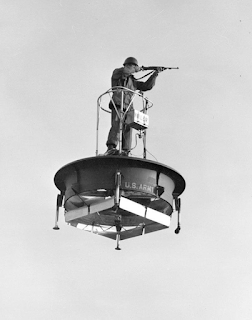Aircraft constructed a series of flying platforms for an Army

In the mid-1950s, Hiller Aircraft constructed a series of flying platforms for an Army-Navy program. The pilot simply leaned in the desired direction and the platform would follow. Hiller Aircraft incorporated twin counter-rotating propellers in a round housing (ducted fan). Sixty percent of the platform’s lift was generated by thrust from the counter-rotating propellers and 40% was generated by air moving over the ducted fan's leading edge (Bernoulli principle). Hughes 269A - History and technical description During the 1950s numerous engineers and builders (especially in the United States), probably inspired by the success of the early helicopters, were convinced that these would soon replace cars. Encouraged by this perceived, but unreal market, they designed and built a long list of one or two-seater to satisfy the hoped demand from private buyers. The majority of these small companies were however forced to close their activities, most of the time because they were bankrupt....